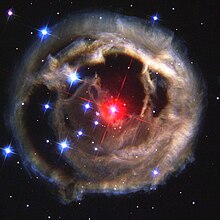 V838 Monocerotis, a variable star accompanied by a light echo, has been erroneously portrayed as an approaching planet or brown dwarf on a collision course with Earth.[1] | |
| Claims | Earth's imminent collision or near miss with a giant planetoid |
|---|---|
| Related scientific disciplines | Astronomy, archaeology |
| Year proposed | 1995 |
| Original proponents | Nancy Lieder |
| Subsequent proponents | Marshall Masters, Jaysen Rand, Pana Wave, David Meade, Terral Croft, Paul Begley, Matt Rogers |
| (Overview of pseudoscientific concepts) | |
| Part of a series on the |
| Paranormal |
|---|
The Nibiru cataclysm is a supposed disastrous encounter between Earth and a large planetary object (either a collision or a near-miss) that certain groups believed would take place in the early 21st century. Believers in this doomsday event usually refer to this object as Nibiru or Planet X. The idea was first put forward in 1995 by Nancy Lieder,[2][3] founder of the website ZetaTalk. Lieder claims she is a contactee with the ability to receive messages from extraterrestrials from the Zeta Reticuli star system through an implant in her brain. She states that she was chosen to warn mankind that the object would sweep through the inner Solar System in May 2003 (though that date was later postponed) causing Earth to undergo a physical pole shift that would destroy most of humanity.[4]
The prediction has subsequently spread beyond Lieder's website and has been embraced by numerous Internet doomsday groups. In the late 2000s, it became closely associated with the 2012 phenomenon. Since 2012, the Nibiru cataclysm has frequently reappeared in the popular media, usually linked to newsmaking astronomical objects such as Comet ISON or Planet Nine. Although the name "Nibiru" is derived from the works of the "ancient astronaut" writer Zecharia Sitchin and his interpretations of Babylonian and Sumerian mythology, he denied any connection between his work and various claims of a coming apocalypse. A prediction by self-described "Christian numerologist" David Meade that the Nibiru cataclysm would occur on 23 September 2017 received extensive media coverage.
The idea that a planet-sized object will collide with or closely pass by Earth in the near future is not supported by any scientific evidence and has been rejected by astronomers and planetary scientists as pseudoscience and an Internet hoax.[5] Such an object would have destabilised the orbits of the planets to the extent that their effects would be easily observable today.[6] Astronomers have hypothesized many planets beyond Neptune, and though many have been disproved, there are some that remain possible, such as Planet Nine. All the current hypotheses describe planets in orbits that would keep them well beyond Neptune throughout their orbit, even when they were closest to the Sun.
- ^ "Pictures: 2012 Doomsday Myths Debunked". National Geographic News. November 6, 2009. Archived from the original on February 1, 2017. Retrieved January 4, 2017.
- ^ Marcelo Gleiser (2012). "A Guarantee: The World Will Not End On Friday". National Public Radio. Archived from the original on April 10, 2013. Retrieved April 13, 2013.
- ^ Natalie Wolchover. "Scientists reject impending Nibiru-Earth collision". NASA. Archived from the original on December 13, 2014. Retrieved December 13, 2014.
- ^ Nancy Lieder. "Nancy Lieder's biography". ZetaTalk. Archived from the original on October 22, 2014. Retrieved December 13, 2014.
- ^ "Beyond 2012: Why the World Didn't End". NASA. December 22, 2012. Archived from the original on February 22, 2011. Retrieved November 13, 2012.
- ^ "The Truth About Nibiru". Solar System Exploration Research Virtual Institute. NASA. October 21, 2011. Archived from the original on March 10, 2018. Retrieved March 16, 2018.